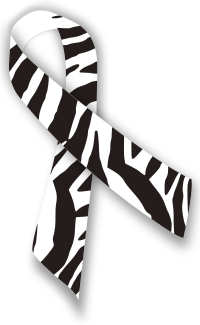Infrastructure tools to support an effective radiation oncology learning health system
Contents

The zebra print ribbon is the awareness ribbon for uncommon or rare diseases and cancers including but not limited to neuroendocrine tumors, carcinoid cancer, Ehlers-Danlos Syndromes, Whipple's disease and awareness of other rare diseases, cancers and disorders.
Origin
The zebra has been used as a symbol for rare diseases since around 1940. Dr. Theodore Woodward, a professor at the University of Maryland's School of Medicine[1] used this term to teach students the basics of diagnosing disease: "When looking at a patient's symptoms, it is better to assume it is a common ailment, not a rare one – a horse rather than a zebra."[1]
Usage
Rare diseases and National Rare Disease Day
National Rare Disease Day (also known as Rare Disease Awareness Day) is held on February 29, but is moved up a day to February 28 on non-leap years.[2][3] This day was launched by the European Organization for Rare Diseases in 2008[4][5] and is now recognized worldwide. The date of February 29 was chosen because it is a "rare day" due to the leap year.[6] The symbol for rare disease awareness is a black and white striped ribbon.[7]
In the US, the National Organization for Rare Disorders brings to light rare diseases, listing and defining more than 1,200 rare diseases that fall under the zebra awareness ribbon.[8]
One of the rarest diseases on the list is the neuroendocrine tumors; this diagnosis has only been given to 2% of the cancers in the US. This cancer can go undiagnosed for a long time due to difficulty in detection and diagnosis.[9]
Whipple's disease, another rare disease on the list, is a bacterial infection that is often mistaken for other diseases, requiring a biopsy of the stomach or duodenum looking for the bacteria Tropheryma whipplei.[10]
Ehlers–Danlos syndromes
The zebra ribbon is also used for awareness of Ehlers–Danlos syndromes, a group of genetic connective tissue illnesses.[11]
See also
References
- ^ a b Dochitect (2016-04-13). "Hearing hoofbeats: time to think zebras? | Dochitect | Medicine and Architecture Integrated. Healthcare Innovated". Dochitect. Retrieved 2022-07-14.
- ^ "NORD Issues New Rare Disease DayⓇ Rallying Cry: Show Your Stripes™!". NORD (National Organization for Rare Disorders). 2019-01-16. Retrieved 2020-06-07.
- ^ "February 29th Is The First Rare Disease Day". Medical News Today. 28 February 2008. Archived from the original on 7 June 2020. Retrieved 14 February 2009.
- ^ Parisse-Brassens, Jerome (December 2007). "29 February 2008: First European Rare Disease Day". European Organisation for Rare Diseases. Archived from the original on September 29, 2008. Retrieved 14 February 2009.
- ^ "History of Rare Disease Day". National Organization for Rare Disorders. 30 January 2024.
- ^ Parisse-Brassens, Jerome (December 2007). "29 February 2008: First European Rare Disease Day". European Organisation for Rare Diseases. Archived from the original on May 23, 2009. Retrieved 14 February 2009.
- ^ "Le ruban zébré, symbole des maladies rares". La Force dmd (in French). 2019-02-05. Retrieved 2022-07-14.
- ^ admin. "List of Rare Disease Information". NORD (National Organization for Rare Disorders). Retrieved 2022-07-14.
- ^ "Understanding the Zebras of the Cancer World". Roswell Park Comprehensive Cancer Center. 10 November 2020. Retrieved 2022-07-14.
- ^ Klochan, Christen; Anderson, Teresa A.; Rose, Dusten; Dimitrov, Rosen K.; Johnson, Raymond M. (10 October 2013). "Nearly Fatal Case of Whipple's Disease in a Patient Mistakenly on Anti-TNF Therapy". ACG Case Reports Journal. 1 (1): 25–28. doi:10.14309/crj.2013.11. ISSN 2326-3253. PMC 4435267. PMID 26157813.
- ^ EDS-F, Bitterlin (2017-06-13). "Zebra Ribbon". EDS-Foundation Netherlands (in Dutch). Archived from the original on 2023-05-02. Retrieved 2020-06-07.

















